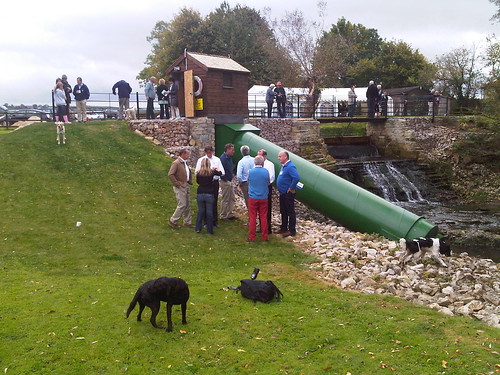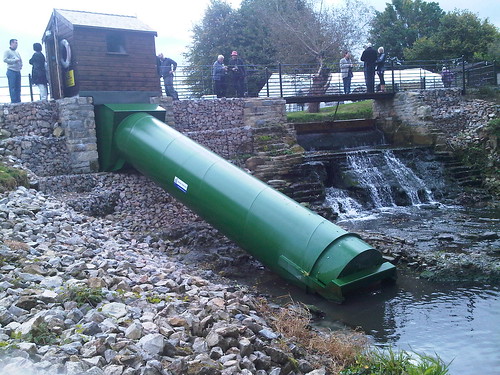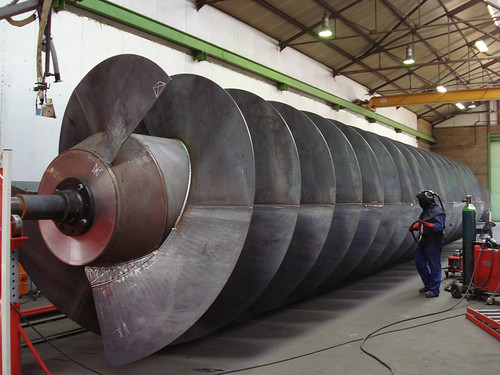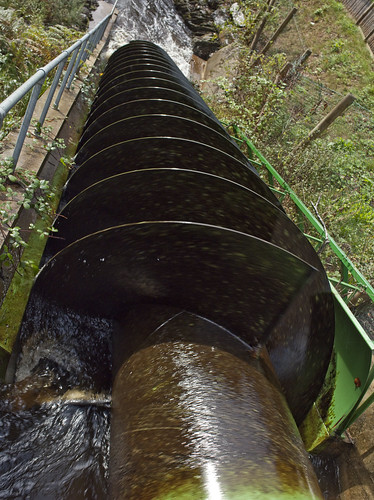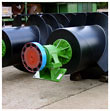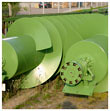Solar Power – PV Panels Hydro Screw Hydro Energy Everything About Solar Power and Hydro Screw Power Under the Sun Run by Harish Dabasia Known as UKs most connected person in the PV Solar Power/Hydro Screw Energy sector Advocate, Ambassador, Introducer, Influencer, Facilitator and Deal maker.
Google Analytics
Sunday 31 July 2011
Archimedes screw used for Hydropower Generator. The Archimedes screw – used for over 2000 years as a pump is now becoming a popular Micro Hydro technology choice.Harish Dabasia at Mini Hydro Power Showhttp://ping.fm/Suyak
Saturday 30 July 2011
Hydro dynamic Screw Pump operates by turns the Archimedes' screw trough pump into a power generator for the extraction of energy. Of a hydrodynamic screw (hydrodynamic screw )
http://ping.fm/BC2Cx
http://ping.fm/4KpW8
Open Archimedean screw .Archimedes screw is used for the rising of water by the screw of Archimedes.
http://ping.fm/zFVJl
Installers of the Hydrodynamic Screw Turbine recommends considering intelligent control systems for a hassle free or unmanned Hydro dynamic Screw Turbine systems.
http://ping.fm/yUYrm
Archimedes Hydro Screw has been developed to be ideal for use in high volume and low head hydro Micro Hydro sites.
semi-compact type Hydroscrew
http://ping.fm/Sutd4
The UK's first hydrodynamic screw Power generator, modeled on the ancient 'Archimedes Screw', is providing power for the River Dart Country Park near Ashburton
http://ping.fm/kO5W5
Hydro dynamic Screw Energy is extracted , when an Archimedes Screw comes in contact with water
http://ping.fm/NV4TN
Learn about small Hydro Screw Turbine and how a micro-hydro system can benefit your home power system
http://ping.fm/x7g0Y
http://ping.fm/Vy2Sk
Archimedes Screw Pumps produced two Archimedes screw pumps for a new wastewater treatment facility in Londonhttp://ping.fm/wcPaq
Hydro Power using Waste Water at Esholt WwTW
Hydro Power using Waste Water at Esholt WwTW
The Spaans Babcock Screw Generators were switched on at Yorkshire Water in June 2009. Following a short and successful commissioning period the generators are now running 24/7 to provide up to 180kW of renewable energy into the grid system reducing site running costs.
Two Archimedean screws are installed in series, each with a capacity of 90kW. The flow is fed from the inlet works upstream of the generators via an intake/bypass chamber with fast acting hydraulic weir gates and an overflow bypass facility.
Eureka! How Archimedes and his 2,000-year-old invention will help provide green energy
A device invented more than 2,000 years ago by Archimedes has found a 21st century use - generating 'green' electricity.
Eureka! How Archimedes and his 2,000-year-old invention will help provide green energy
A device invented more than 2,000 years ago by Archimedes has found a 21st century use - generating 'green' electricity.
A crumbling 99-year-old hydroelectric plant in the Yorkshire Dales will come out of retirement thanks to the Ancient Greek's genius.
Key to the English Heritage project is the adaptation of Archimedean screws to operate turbines.
The screw was designed to carry water upwards as it rotates, but the project at the Linton Falls plant has reversed this principle.
The river Wharfe will flow down through two screws, spinning them fast enough to generate enough renewable and clean energy to power 100 homes.
Archimedes of Syracuse (287-212 BC) has been credited with inventing the screw to remove water from the hold of a ship.
The revolving screw-shaped blade inside an angled pipe was turned by a handle, scooping up water and carrying it to the top.
The same technology has been widely used to pump water from low-lying rivers for crop irrigation, as it is still used in the Nile delta in Egypt.
The method is also used to drain flooded fields, move grain in mills and powders in factories.
The tiny Linton Falls plant was built in 1909 to bring the first electricity to the village of Grassington, but has been out of action since 1948.
By next summer it should once more be generating electricity for the National Grid.
It will produce 510,000 kilowatt hours of electricity a year, saving around 216 tons of carbon dioxide emissions compared with fossil fuel generation.
'There is sometimes a feeling that technology is everything and we must always be striving for the latest developments. But quite often the older, tried-and-tested methods are just as good, if not better.
The scheme's cost has not been revealed. 'Archimedes should be pleased,' said Austin Flather, the project manager.
'I think if he saw us using his technology this way he would smile. Frankly it is not highly sophisticated - which is a good thing. It's easier and cheaper to build, maintain and operate than more modern systems.
The 100-year-old defunct hydro plant at Linton Falls is to be refurbished and put back into use to create green power
'Also, circumstances are changing and this kind of smaller installation is becoming viable where it would not have been just a few years ago. It fits with the government requirements for green renewable energy technology. This method takes nothing away from the river, nor adds anything to it.'
The Yorkshire Dales National Park Authority is considering up to 50 sites for small hydro-electricity schemes.
Chief planner Peter Watson said: 'This project brings together two vital characteristics of the National Park - the protection of its cultural heritage and the promotion of new technologies to meet the climate change challenge and protect the environment.'
http://ping.fm/LUxZ4
Archimedes HydroScrew Generating Electricity
http://ping.fm/AX43y
http://ping.fm/1LX58
Small Archimedes Screw Generator What a fantastic piece of tec.
http://ping.fm/uSJuo
Archimedean screw turbine lifted over the power house.
Copley. Hydropower Generator uses The Archimedes screw hydro generator
http://ping.fm/Xz8uT
The fish-friendly screw pump is build in a composite material around a steel shaft.
http://ping.fm/I6fnN
http://ping.fm/0dnyW
Why Google+ is Great for SEO
We found that Google+ is a great source of links that can be used for SEO benefit.
Why Google+ is Great for SEO
Having landed and created huge ripples in the social networking sphere, Google+ has continue to grow at a particularly rapid pace, increasing by over 10 million users in the space of a week, having now reached 20 million. There’s been a great deal written about it in comparison with Facebook and to some extent Twitter, but I’d like to draw on one of the key ways that it differs from the two; SEO.
Having done some digging with the rest of the team at PR company Punch to find out a bit more about how it works, we found that Google+ is a great source of links that can be used for SEO benefit. It’s interesting to see that Google has opted to allow links that pass page rank in contrast to the other major networks such as Facebook and Twitter which only allow links that Google’s spiders can’t follow, and I think it’s likely that this could be part of the Google+ project strategy to grow as big as the two social media giants.
With Google co-founder Larry Page confirming the popularity of the network last week, it can be assumed that the Google+ proposition to users is strong, and generating links from the network for SEO benefit could become all the more important for the future.
At present, there are a number of potential areas for the placement of links that pass on SEO benefit to the destination webpage:
- Google+ posts - The area that is likely to be used most frequently by users is the posting feature; links found here are valuable links for SEO. This is also likely to be the place where the most dynamic links are found, so it’s probable that Google may only assign short-term weight to these links.
- The “About Me” section - In addition, the ‘About Me’ section of each user’s profile can include SEO beneficial links too. This may be of great advantage to users with their own blogs, and indeed brands and businesses who have subscribed for the opportunity to set up business pages on Google+ akin to brand pages on Facebook. Depending on the authority of the user or brand, these static links may be of more value than those in Google+ posts.
As a result of the above we may start to see some of the more search-minded brands encouraging their consumers to engage with their content through Google+, as a means of directing valuable links back towards whatever social object they have created. This may be difficult at present given that brands can’t yet establish themselves on the network, but it’s certainly a possibility for the future, since allowing brands to engage with fans is likely to be a key source of revenue for Google. In addition, the integration of the +1 button earlier this year shows up within users’ Google+ profiles, adding yet another incentive for brands to implement the +1 button too.
From my perspective working at a social media agency, this is certainly another change on the horizon that it’s imperative to keep on top of and an opportunity to be taken.
What is Google’s Panda Update?
What is Google’s Panda Update and is it Positive for the SEO Industry?
Four Reasons Google’s Panda Update is Positive for the SEO Industry
The update to Google’s algorithm referred to by many as “Panda” has stirred a great deal of conversation within the search community, with its effects being felt by a number of high profile websites across the internet. Google has endeavoured to combat the effects of spam within its results for some time now, so it’s not really a surprise that the update penalised some of the link farms influencing search rankings.
From the perspective of an SEO agency or in-house digital PR or marketing expert, the Panda update isn’t all bad news. Below are a number of reasons that the update is a positive development for the SEO industry:
- Increased requirement for SEO services – Many digital marketers who thought they had perfected their SEO strategy may find that their rankings have shifted as a result of Panda. As such, this may encourage those with greater marketing budgets to enlist the consultancy of an SEO specialist, who can advise on the best course of action to remedy any fluctuations caused by the changes as much as possible.
- More focus on on-site and PR led SEO strategies – The Panda update has affected a great number of article and link sites because link placement within those sites is considered too easy to achieve. As a result of this, companies will look to bolster their search activity with a renewed emphasis on on-site or PR-led SEO strategies. This is not to say that links from article sites are bad, they are still important, but the most valuable links are those from reputable online blogs and publication websites.
- Less spam and link farms to contend with – If anything the Panda update does more to refine SEO by disregarding the websites that would normally be considered as spam. Links from reputable sites have become more important and whilst social networking content can still be used to spam links, the Panda update is another step in the right directions. Which leads nicely into the next point...
- A deterrent to some black-hat techniques – The Panda update has taken more steps to clean up the SEO industry and places more focus on ethical strategies by discounting any value from link farms and sources of web spam. This can only be a good development for the industry and hopefully future updates continue to move towards the same goal.
Whilst most of the fluctuations in search results have now steadied, there’s little doubt across the SEO industry that there will be further changes and algorithm tweaks down the line. With that in mind, I’d predict that SEO consultancy will become even more important for long-term success in search.
http://ping.fm/nv4XI
http://ping.fm/7gb6L
http://ping.fm/tzQw1
Thursday 28 July 2011
archimedes screw hydro generator
Archimedes screw used for Hydropower Generator. The Archimedes screw – used for over 2000 years as a pump is now becoming a popular Micro Hydro technology choice.Harish Dabasia at Mini Hydro Power Show
Hydro dynamic screw generator
Harish Dabasia at Mini Hydro Power Show
Mini Hydro Technology adopts Hydro dynamic screw generator for renewable electricity generation
Tuesday 26 July 2011
hydroscrew Diagram
hydro screw Diagram shows the Archimedes Screw Turbine detailed technical drawing
Monday 25 July 2011
Plastic Archimedes Screw
A HISTORIC Water wheel hydro-electric scheme once used to power a sanatorium is be revived by a Highland community after 70 years, by replacing it with Plastic Archimedean screw turbine
Hydrodynamic Screw Blades
generator; screw generator; Archimedean screw; hydropower screw; hydrodynamic screw ... The water flows into the spaces between Blades of the turns the generator
Archimedes Screw Couplings and Bearing
Archimedean Screw Hydro Turbine tests have conclusively demonstrated that the large Roller bearings are best used in some kind of Archimedes screw.
Archimedean Screw Couplings
Heavy duty flexible pin and bush coupling is used between the drive shaft of the Archimedean Screw Turbine and the Gearbox
Sunday 24 July 2011
HOW AN ELECTRIC GENERATOR WORKS
HOW AN ELECTRIC GENERATOR WORKS
electric energy. The mechanical energy in turn is produced from chemical or nuclear energy in various types of fuel, or
Steam turbines, internal-combustion engines, gas combustion turbines, electric motors,
water and wind turbines are the common methods to supply the mechanical
energy for such devices. Generators are made in a wide range of sizes, from very small machines
with a few watts of output power to very large power plant devices providing gigawatts of power.
The electric generator animation below demonstrates an example on how a generator works to produce
energy. Two black arrows show the direction of the coil rotation. The blue lines represent magnetic field directed from north pole to south pole. The red arrows show the instantaneous direction of the induced AC current
Please wait a few seconds while the applet is loading (during which your browser may briefly freeze). Don't refresh the page while it is loading. The animation requires a JRE and a javascript-enabled browser.
The applet is courtesy of Walter Fendt, URL: http://www.walter-fendt.de/ph14e/
©Walter Fendt, May 8, 1998ELECTRIC GENERATORS: HOW THEY WORK
Operation of power generators is based on the phenomenon of
electromagnetic induction: whenever a
conductor moves relative to magnetic field, voltage is induced in the conductor.
Particularly, if a coil is spinning in a magnetic field, then the two sides of the coil move in opposite directions, and the voltages induced in each side add. Numerically the instantaneous value of the resulting voltage (called electromotive force, emf) is equal to the minus of the rate of change of magnetic flux Φ times the number of turns in the
coil: V=−N•∆Φ/Δt. This relationship has been found experimentally and
is referred to as Faraday's law. The minus sign here is due to Lenz law, which states that the direction of the emf is such that the magnetic field
from the induced current opposes the change in the flux which produces this emf. Lenz law is connected to the conservation of energy.
For clarity in the above animation a single rectangular conductor loop is shown instead of an armature with a set of windings on an iron core. Since the rate of magnetic flux change through the coil that spins at a constant rate changes sinusoidally with the rotation, the voltage generated at the coil terminals is also sinusoidal (AC). If an external circuit is connected to the coil's terminals, this voltage will create current through this circuit, resulting in energy being delivered to the load. Thus, the mechanical energy that rotates the coil is converted into electrical energy. Note that the load current in turn creates a magnetic field that opposes the change in the flux of the coil, so the coil opposes the motion. The higher current, the larger force must be applied to the armature to keep it from slowing down. In the animation the coil is rotated by the hand crank. In practice, the mechanical energy is produced by turbines or engines called prime movers. In a small AC generator a prime mover is usually a rotary internal-combustion engine. In commercially available devices an alternator is integrated with this engine into a single appliance. The resulting device is referred to as engine-generator set or genset, although casually it is often called just a generator. A genset is the most common and probably the cheapest emergency backup power source for home use. Cheap generators sell for as low as $100 per kilowatt.
Note that the production of the voltage depends only on the relative motion between the coil and the magnetic field. EMF is induced by the same physics law whether the magnetic field moves past a stationary coil, or the coil moves through a stationary magnetic field. In the animation, the magnetic field is produced by a fixed magnet while the coil is revolving. Today's AC gensets are usually brushless. They have spinning field and a stationary power-producing armature. This armature comprises of a set of coils that form a cylinder. Also, in practice, the magnetic field is usually induced by an electromagnet rather then a permanent magnet.The electromagnet consists of
so called field coils mounted on an iron core. A current flow in the
field coils produces the magnetic field. This current may be obtained
from an external source or from the system's own armature. Regulation
is achieved by sensing the output voltage, converting it to a DC, and
comparing its level to a reference voltage. An error is used to control
the field in order to maintain a constant output. Most modern AC
sources with field coils are self-excited:
the current for field coils is supplied by an additional exciting winding in the armature.
How does self excitation works? The exciter's output voltage is
rectified by a diode bridge and usually is fed into a voltage regulator. When output AC current is generated, a portion of it flows
into field coil to generate magnetic field. The initial magnetic field before the device started is produced by residual magnetism in electromagnet's cores or is created by a electric current driven from a battery during engine cranking.
The residual magnetism of the exciter's core may be lost or weakened by external magnetic fields from any source, or by
non-operation for a long time. Some genset models provide automatic field flashing. Otherwise, if the electromagnet's core lost its residual magnetism, the rotor will spin, but no AC output voltage will be produced. In this case, to start the device you may need to do so-called generator field flashing. Here is a typical field flashing
procedure: stop the engine, disconnect exciter field leads from the voltage regulator (note the polarity of the leads), and turn the
circuit breaker off. Then briefly apply voltage from an external battery or another DC source in series with a 10-20 Ohm 25W limiting resistor or a bulb to the field coil while observing polarity. Allow the field to be flashed for some 10 seconds, then remove the external voltage source, and finally reconnect the exciter coil. For a particular model consult your owner's operation manual for the recommendations.
Saturday 23 July 2011
Friday 15 July 2011
Government unveils £110 billion electricity market reforms
Electricity prices just keep climbing there seems to be no end on site.
Government unveils £110 billion electricity market reforms
The Government is set to invest £110 billion in revamping the UK’s electricity generation infrastructure, according to a new White Paper from the Department of Energy and Climate Change (DECC).
At present renewables account for just 3% of the UK’s energy generation portfolio, but the White Paper on Electricity Market Reform (EMR) outlines a plan to raise this number to 30% by 2030. The wholesale reforms will look to protect the country from fluctuating oil prices by replacing nearly one-quarter of the country’s outdated power generation portfolio with new solar, wind, nuclear, gas and coal power stations. EMR will also help the UK meet its legally-binding carbon targets.
